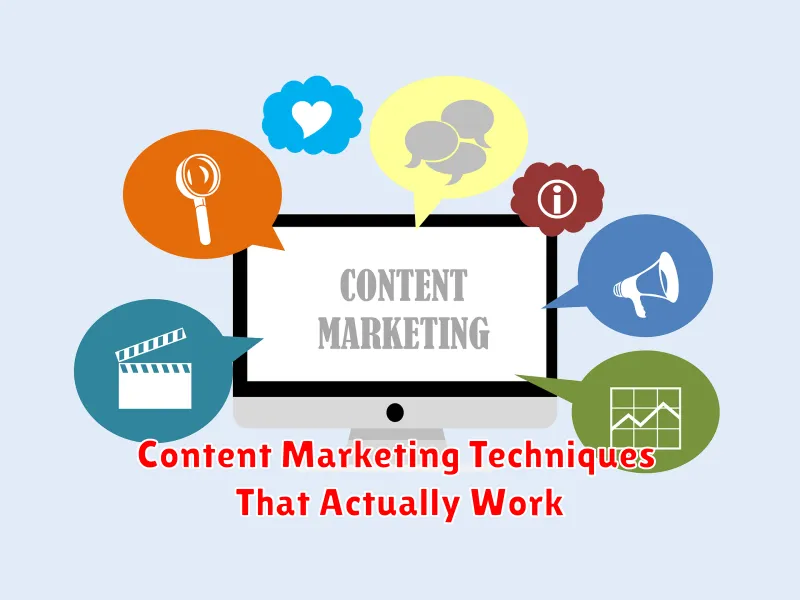In today’s digital landscape, content marketing is more crucial than ever for businesses seeking to establish a robust online presence and connect with their target audience. Effective content marketing techniques can drive organic traffic, generate leads, and ultimately boost conversions. However, simply creating content is not enough; it must be strategically crafted and implemented to achieve desired results. This article will delve into proven content marketing techniques that actually work, providing actionable insights to help you enhance your content strategy and achieve measurable success. We’ll explore a variety of methods, from optimizing content for search engines to leveraging the power of social media.
This guide is designed to empower you with the knowledge and tools necessary to implement content marketing techniques that deliver real ROI. Whether you are a seasoned marketer or just beginning your content marketing journey, you will discover valuable strategies to create engaging, high-quality content that resonates with your audience, builds brand authority, and drives business growth. Learn how to harness the power of content marketing to attract, engage, and convert your target audience into loyal customers. We’ll cover topics including keyword research, content promotion, and performance analysis, giving you a comprehensive understanding of what it takes to succeed in the competitive world of content marketing.
What is Content Marketing?
Content marketing is a strategic marketing approach focused on creating and distributing valuable, relevant, and consistent content to attract and retain a clearly defined audience — and, ultimately, to drive profitable customer action.
Instead of pitching your products or services directly, you provide truly relevant and useful content to your prospects and customers to help them solve their problems.
Creating Value-Driven Content
Value-driven content focuses on providing genuine assistance and information to your target audience. It addresses their needs and pain points, offering solutions and insights rather than simply promoting your product or service.
Consider what questions your audience has and create content that answers them comprehensively. This could include how-to guides, tutorials, in-depth articles, or original research. By providing valuable information, you position yourself as a trusted resource, building credibility and fostering long-term relationships with your audience.
Think about the different formats you can use to deliver this value. Could you create a checklist, a template, or a short video explaining a complex concept? Experimenting with diverse formats can help you reach a wider audience and cater to different learning styles.
Repurposing Content for Maximum Reach

Content repurposing is a powerful strategy that involves adapting and transforming existing content into various formats to reach a wider audience and maximize your content marketing efforts. Instead of constantly creating new content from scratch, repurposing allows you to efficiently leverage your existing valuable resources.
Consider transforming a blog post into a compelling infographic, a series of social media updates, or even a short video. A webinar can be broken down into smaller video clips for social media, or transcribed into a blog post or downloadable guide.
By repurposing your content, you not only save time and resources but also increase the visibility of your key messages across different platforms, appealing to different segments of your target audience. It reinforces your expertise and helps establish a consistent brand presence.
SEO-Optimized Content Examples
Creating high-quality, SEO-optimized content is crucial for attracting organic traffic. Here are a few examples demonstrating effective techniques:
Blog Post: “10 Tips for Choosing the Right Running Shoes” incorporates relevant keywords like “running shoes,” “best running shoes,” and “shoe fitting.” The content provides valuable information about choosing running shoes, targeting a specific audience interested in running.
Product Page: A product page for “Noise-Cancelling Headphones” utilizes keywords such as “noise cancellation,” “headphones,” and “wireless.” Detailed descriptions, specifications, and customer reviews enhance the page’s relevance for search engines and users.
Infographic: An infographic titled “The Benefits of Regular Exercise” visually represents data on exercise and health. Keywords like “exercise benefits,” “fitness,” and “healthy lifestyle” are integrated within the infographic and its accompanying text.
Using Storytelling in Brand Messaging
Storytelling is a powerful technique for connecting with your audience on an emotional level. Instead of simply listing features and benefits, weave a narrative that resonates with their values and aspirations.
By incorporating storytelling into your brand messaging, you can achieve several key benefits:
- Increased brand recall and recognition
- Enhanced customer engagement and loyalty
- Building stronger emotional connections with your target audience
Focus on crafting authentic and relatable stories that showcase your brand’s personality and values. This approach helps build trust and credibility, ultimately leading to stronger customer relationships.

